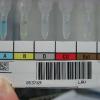Reputation Activity
-
 Dansket got a reaction from NewBBSup in Computer Crossmatching
Dansket got a reaction from NewBBSup in Computer Crossmatching
The user (not the computer) in my facility selects a RBC component from the refrigerator for crossmatching.
Are you restricting the definition of a crossmatch to include only serological methods? In 1987 the AABB allowed users to limit the serological crossmatch to the immediate-spin test if the antiglobulin antibody screen test was negative. Then, in 199?, the AABB allowed users to replace the immediate-spin crossmatch with a "computer crossmatch" to detect ABO incompatibility. Before this, the word "crossmatch" was prefaced with "major" and "minor". So the definition of "crossmatch" has undergone many changes over the years.
The FDA allows Transfusion Services to use a qualified computer system to detect ABO incompatibility between donor and recipient in lieu of serological methods to detect ABO incompatibility, i.e., as stated by tricore, "Computerized Analysis of the Compatibility between the Donor’s Cell Type and the Recipient’s Serum or Plasma Type".
-
 Dansket got a reaction from Winter in Meditech Rules & Calculations
Dansket got a reaction from Winter in Meditech Rules & Calculations
See my Library file "Meditech Unit Confirmation".
-
 Dansket got a reaction from Ensis01 in What are your rules for ruling out?
Dansket got a reaction from Ensis01 in What are your rules for ruling out?
We will rule out C and E in the presence of anti-D with a single C+c+ or E+e+ cell. K may be also ruled out with a single K+k+ cell.
-
 Dansket got a reaction from gagpinks in Donor unit confirmation required in US but not in UK
Dansket got a reaction from gagpinks in Donor unit confirmation required in US but not in UK
I posted this question in UK Guidelines forum and Malcolm responded that isn't a requirement in UK. UK donor centers guarantee that what is in the bag matches the label.
It is not an FDA requirement for transfusion services to serologically confirm the ABO/Rh type of red cell components using rbcs from a donor tubing segment, it's the CAP, AABB, etc.
I'm trying to drum-up interest in the transfusion services community to push their donor centers to implement the same practice in the US that UK donor centers do!
Please don't tell me they can't do it! This is 2015, not 1980...
-
 Dansket got a reaction from Ensis01 in 2ND TYPE FOR O PTS IN ELECTRONIC XM
Dansket got a reaction from Ensis01 in 2ND TYPE FOR O PTS IN ELECTRONIC XM
Yes, if you are AABB accredited, then you must do an ABO determination (as defined in 5.14.1) on the initial blood sample and an ABO determination (as defined in 5.14.1) on the 'retype specimen'. FDA, CAP and other accrediting agencies do not prescribe how the 'retype' must be done.
-
 Dansket reacted to Townsend in Gel Titer on Ortho Vision endpoint
Dansket reacted to Townsend in Gel Titer on Ortho Vision endpoint
We would like to start looking at this, but I didn't think it was FDA approved yet for titrations in the US. Am I wrong Mabel? We are just starting ABO titrations for incompatible heart transplants. We are going to run in gel, and you are correct, that your cut off for gel will be 1+. That being said, there is no weak+ defined for any gel reaction results (technically even if read by manual gel), so if we see any agglutination, we are calling it 1+ (and that would be our titer result). Would love to hear back on how it goes for you.
The note about requiring review if 1+ and lower; that is a setting that you can control on the Vision with your results cutoff on the analyzer, correct?
-
 Dansket got a reaction from Likewine99 in 2ND TYPE FOR O PTS IN ELECTRONIC XM
Dansket got a reaction from Likewine99 in 2ND TYPE FOR O PTS IN ELECTRONIC XM
Electronic crossmatch requires 2 ABO types on file regardless of the initial ABO typing. Patients who don't qualify for the electronic crossmatch may be serologically crossmatched with ABO identical or ABO compatible RBC's regardless of the initial ABO typing.
Meditech will prompt you that patient does not qualify for electronic crossmatch if no second ABO on file. I am not aware that you can override this requirement in Meditech regardless the patient's initial ABO typing.
-
 Dansket got a reaction from David Saikin in 2ND TYPE FOR O PTS IN ELECTRONIC XM
Dansket got a reaction from David Saikin in 2ND TYPE FOR O PTS IN ELECTRONIC XM
Electronic crossmatch requires 2 ABO types on file regardless of the initial ABO typing. Patients who don't qualify for the electronic crossmatch may be serologically crossmatched with ABO identical or ABO compatible RBC's regardless of the initial ABO typing.
Meditech will prompt you that patient does not qualify for electronic crossmatch if no second ABO on file. I am not aware that you can override this requirement in Meditech regardless the patient's initial ABO typing.
-
 Dansket reacted to AMcCord in Informed consent. Who explains risks/benefits?
Dansket reacted to AMcCord in Informed consent. Who explains risks/benefits?
Informed consent should be done by the physician, as it is for other treatments/procedures. Risk/benefit explanations should be done by the individual ordering the transfusion as he/she is the person who is 'supposed' to be most familiar with the patient's condition. For some reason, consent for transfusions isn't taken as seriously as it should be. Shoving the responsibility onto nursing staff isn't fixing the problem. That's a tough one but it's something that I think is going to be a TJC issue - once a problem fits in that category, you have more teeth to address it.
-
 Dansket reacted to AMcCord in Antibody Titers
Dansket reacted to AMcCord in Antibody Titers
You will have to perform Ab titer surveys. CAP surveys for titers are rather pricey.
Most of the patient results are more of a followup thing - important, but generally not emergent. The vast majority will not need same day turn around, so as long as your reference lab can give you results in a day or 2, that shouldn't be a problem. All titers we did or that we send out are done in parallel with the previous specimen, if sufficient specimen is available. Malcolm has given a great explanation as to why that is important. We stopped doing titers several years ago. We had plenty of work without bogging down our day with titers, the surveys were expensive, the reference charge was/is reasonable - doing them just wasn't worth it. If we need results quickly, we have the option of requesting them STAT. No complaints from physicians about our turn around times. Our OB docs order titers on their patients at each monthly visit unless the titer skyrockets - at that point they stop the titers and refer them to specialists at a major medical center for monitoring.
-
 Dansket got a reaction from tcoyle in 2ND TYPE FOR O PTS IN ELECTRONIC XM
Dansket got a reaction from tcoyle in 2ND TYPE FOR O PTS IN ELECTRONIC XM
Electronic crossmatch requires 2 ABO types on file regardless of the initial ABO typing. Patients who don't qualify for the electronic crossmatch may be serologically crossmatched with ABO identical or ABO compatible RBC's regardless of the initial ABO typing.
Meditech will prompt you that patient does not qualify for electronic crossmatch if no second ABO on file. I am not aware that you can override this requirement in Meditech regardless the patient's initial ABO typing.
-
 Dansket got a reaction from Malcolm Needs in 2ND TYPE FOR O PTS IN ELECTRONIC XM
Dansket got a reaction from Malcolm Needs in 2ND TYPE FOR O PTS IN ELECTRONIC XM
Electronic crossmatch requires 2 ABO types on file regardless of the initial ABO typing. Patients who don't qualify for the electronic crossmatch may be serologically crossmatched with ABO identical or ABO compatible RBC's regardless of the initial ABO typing.
Meditech will prompt you that patient does not qualify for electronic crossmatch if no second ABO on file. I am not aware that you can override this requirement in Meditech regardless the patient's initial ABO typing.
-
 Dansket got a reaction from goodchild in Unit segments
Dansket got a reaction from goodchild in Unit segments
To minimize the number of steps required to issue blood, we retain donor tubing segments as part of the ABO/Rh confirmation process on receipt of donor units from the donor center. I dislike trying to find the end of the donor tubing that is tightly rubber-banded together under any circumstance and certainly not when a nurse is standing beside me!
-
 Dansket got a reaction from exlimey in Unit segments
Dansket got a reaction from exlimey in Unit segments
To minimize the number of steps required to issue blood, we retain donor tubing segments as part of the ABO/Rh confirmation process on receipt of donor units from the donor center. I dislike trying to find the end of the donor tubing that is tightly rubber-banded together under any circumstance and certainly not when a nurse is standing beside me!
-
 Dansket got a reaction from mollyredone in What are your rules for ruling out?
Dansket got a reaction from mollyredone in What are your rules for ruling out?
We will rule out C and E in the presence of anti-D with a single C+c+ or E+e+ cell. K may be also ruled out with a single K+k+ cell.
-
 Dansket got a reaction from Malcolm Needs in Using only mixed field anti-D (ortho gel) as qualitative indicator for RhIg eligibility
Dansket got a reaction from Malcolm Needs in Using only mixed field anti-D (ortho gel) as qualitative indicator for RhIg eligibility
Malcolm, please re-read my post. Mixed-field is a term used to describe the observation of a microscopic reading on a slide of the contents of a standard tube test where there may be seen "individual clumps of red cells in sea of unagglutinated red cells".
Two populations of red cells will be present in a group A recipient of a group O red blood cell transfusion. When testing a post-transfusion blood sample, a band of agglutinated red cells will be trapped at the top of the gel column, a button of red cells will be seen at the bottom of the gel column and no red cells trapped within the anti-A gel column. These observations are visible without the aid of a magnifying device and are graded as dp dual-population according to MTS-ID Gel Card Interpretation Guide used for both manual and automated gel testing.
-
 Dansket reacted to SMILLER in Continuing Issues with Ortho Gel Reagents and or Equipment
Dansket reacted to SMILLER in Continuing Issues with Ortho Gel Reagents and or Equipment
We have not really had that much trouble recently; though we have had some issues off and on over the years.
Scott
-
 Dansket reacted to Malcolm Needs in What is possible thing will occurs when we give B+ PRBCs for A+ female patient ?
Dansket reacted to Malcolm Needs in What is possible thing will occurs when we give B+ PRBCs for A+ female patient ?
I would advise A+, BUT, I am not a doctor.
-
 Dansket reacted to exlimey in Antibody Panel Validation
Dansket reacted to exlimey in Antibody Panel Validation
My personal opinion - no validation required.
You are switching from one FDA-licensed product to an equivalent. Unless you plan to use it in a fashion contrary to the manufacturer's instructions it's a business decision rather than one of quality or performance.
If you have an internal policy that directs you to "validate" in these situations, you should change that policy. Anything that an end user does to "validate" a commercial, FDA-licensed red cell panel is dwarfed by the process involved to get these products to the market.
Perhaps more important is that the replacement product suit your facility's specific needs. The typical antigenic make-up of the panel you select should reflect your particular testing requirements. For example....if you have lots of patients with anti- D, a panel with lots of D+ cells my not be very useful.
-
 Dansket got a reaction from tricore in pre-transfusion sample aliquot
Dansket got a reaction from tricore in pre-transfusion sample aliquot
Why do you aliquot these blood samples? Do I assume correctly that you are separating serum/plasma from red cells?
I am adamantly opposed to routinely aliquotting pre-transfusion blood samples for several reasons. It is an unnecessary step that does not enhance the process. It iintroduces another potential point of failure. It takes time. Storage space requirements are effectively doubled.
-
 Dansket got a reaction from mollyredone in SIGNIFICANT ANTIBODIES FOR ELECTRONIC XM
Dansket got a reaction from mollyredone in SIGNIFICANT ANTIBODIES FOR ELECTRONIC XM
So does Meditech C/S 5.67. For security purposes, our IT department has configured all terminals to automatically log out after 5 minutes of inactivity. For our purposes, it is extremely efficient to be able to visually access that information from the specimen container label as opposed to the many computer steps required to access the information from the Meditech; login to terminal, launch Meditech, login to Meditech, navigate menu system to Enter/Edit results, scan in specimen number, click on tab to view history, select history option and finally view antibody, etc.
-
 Dansket got a reaction from Carrie Easley in pre-transfusion sample aliquot
Dansket got a reaction from Carrie Easley in pre-transfusion sample aliquot
Why do you aliquot these blood samples? Do I assume correctly that you are separating serum/plasma from red cells?
I am adamantly opposed to routinely aliquotting pre-transfusion blood samples for several reasons. It is an unnecessary step that does not enhance the process. It iintroduces another potential point of failure. It takes time. Storage space requirements are effectively doubled.
-
 Dansket reacted to Malcolm Needs in Routine Testing on Newborns
Dansket reacted to Malcolm Needs in Routine Testing on Newborns
It would be interesting to hear exactly why the new paediatrician wants to go back to this testing regime, considering that it has been known for decades that the DAT in a case of ABO HDN can be negative for a couple of days from birth, and only then become positive. May I respectfully suggest that this new paediatrician relies on his or her ability to look at the baby's symptoms, rather than his or her ability to read laboratory results. This way, more babies may survive.
-
 Dansket got a reaction from AMcCord in SIGNIFICANT ANTIBODIES FOR ELECTRONIC XM
Dansket got a reaction from AMcCord in SIGNIFICANT ANTIBODIES FOR ELECTRONIC XM
Upon completion of initial testing with a conclusion of INC, samples are routinely sent to a reference laboratory. If the reference laboratory concurs with our result, we enter INC in Meditech. If the current antibody screen is negative and there is a historical antibody identification reported as INC, the patient qualifies for electronic crossmatch.
-
 Dansket got a reaction from AMcCord in pre-transfusion sample aliquot
Dansket got a reaction from AMcCord in pre-transfusion sample aliquot
To me, it is not a common practice, because I eliminated it wherever I encountered this practice. Separating serum/plasma for a Reference lab is a separate issue because you are sending them a known problem.
Do you have an example of a problem that occurred in your facility that was directly linked to not separating serum/plasma from a whole blood sample immediately after centrifugation? Did this problem occur in a known patient or a patient new to your facility? Does this occur frequently, rarely or is this the only known example? These are some of the questions I would ask before memorializing the process in a procedure manual.
Unless you have accumulated evidence to support the assertion that separating serum/plasma actually prevents problems frequently encountered in your facility, you have to look to other reasons to justify doing this.
If this problem occurs in 1/10 patients, I would be doing it. Otherwise, I view separation of serum/plasma from red cells to be a “solution looking for a problem”.







